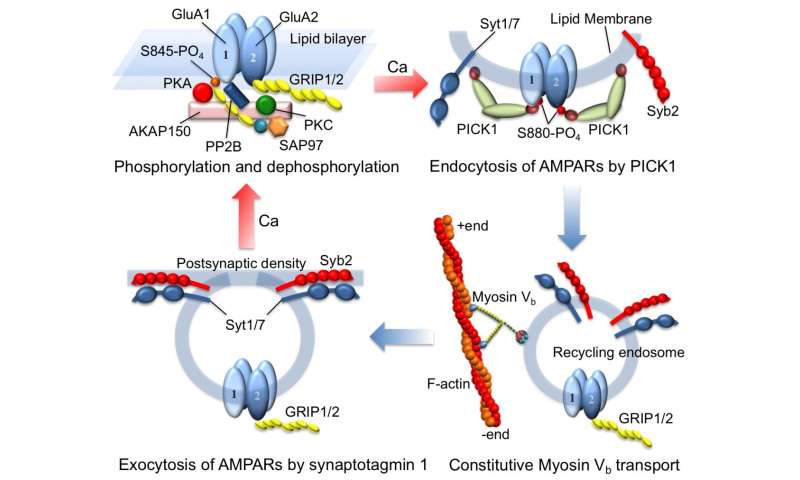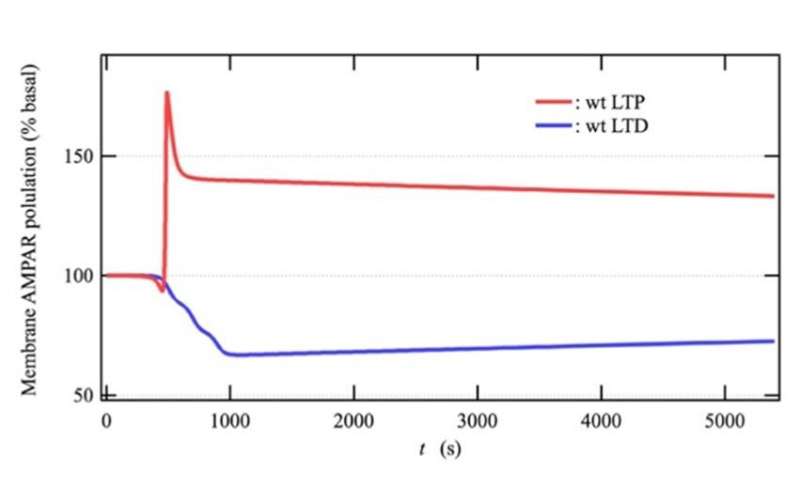
The long-term potentiation (LTP) and long-term depression (LTD) of the strength of hippocampal excitatory synapse involved in learning and memory formation in brain have been separately explained, but the molecular mechanism that comprehensively explains them has not been elucidated. Associate Professor Dr. Tomonari Sumi, Research Institute for Interdisciplinary Science, Okayama University, and Assistant Professor Dr. Kouji Harada, Department of Computer Science and Engineering, Toyohashi University of Technology focused on the competition of exocytosis and endocytosis of AMPA-type glutamate receptors dependent on the number of calcium ions that flow into the postsynapse of hippocampal excitatory neurons, and demonstrated the comprehensive understanding of the LTP and LTD by a large-scale mathematical model simulation.
N-methyl-D-aspartate (NMDA)-type glutamate receptor (NMDAR)-dependent long-term potentiation (LTP) and long-term depression (LTD) in synapses on hippocampal excitatory neurons are considered to be a molecular basis essential to form neural circuits involved in learning and memory. In mammalians, it is confirmed that the main factor of the induction of LTP and LTD results in an increase and decrease in α-amino-3-hydroxy-5-methyl-4-isoxazolepropionic acid (AMPA)-type receptor (AMPAR) at the postsynaptic membrane depending on the calcium ion volume. However, the mechanism on the varying number of the AMPAR has not been elucidated. In addition, there are the following disputes for the main pathway for AMPAR trafficking to the postsynaptic membrane.
Penn, et al. showed that the long-range lateral diffusion of AMPAR directed from the areas other than the postsynaptic membrane (e.g. dendrite shaft) to the postsynaptic membrane is the main pathway for AMPAR trafficking for the LTP, and the long-range lateral diffusion pathway has been considered to be the most likely candidate as the main pathway. On the other hand, Wang et al. demonstrated the importance of the active transport of recycling endosomes containing AMPAR by molecular motor myosin Vb, and Wu et al. observed the exocytosis of the recycling endosomes containing AMPAR during the induction of LTP. These studies embodied the elemental processes of AMPAR trafficking via the recycling endosome pathway. Currently, it is still unknown which pathway for AMPAR trafficking is the main one, but as these disputes are basically involved in the induction of LTP, it has been considered desirable to be able to explain the pathway including the induction of LTD without inconsistency.

Dr. Sumi and Dr. Harada modeled the following 4 processes involving “active” transport of recycling endosomes of AMPAR by molecular motor myosin Vb as pathway for AMPAR trafficking to the postsynaptic membrane in order to comprehensively explain the LTP/LTD.
- AKAP150 signaling complex controlling the phosphorylation/dephosphorylation of subunits, GluA1 and GluA2, that constitute AMPAR
- Endocytosis of AMPAR to the cytoplasm by a calcium-binding protein, PICK1
- Stationary active transport of recycling endosomes containing AMPAR toward postsynaptic membranes by myosin Vb
- AMPAR uptake at around postsynaptic membranes by Syt1/7-dependent exocytosis
We performed a simulation using a postsynaptic model based on these processes and succeeded in reproducing the time course of the number of AMPAR corresponding to the induction of LTD and LTD observed in the experiment. We also showed the qualitative reproducibility of the results reported such as impaired LTP induction due to interference of Myosin Vb transport, impaired LTD induction due to decreased rate of reaction of PP2B-dependent dephosphorylation of AMPAR, impaired LTP and LTD inductions due to PICK1 expression level, and impaired LTP induction in Syt1 calcium-binding domain mutant, demonstrating the validity of the model. The conclusions drawn from this simulation are as follows.

Source: Read Full Article